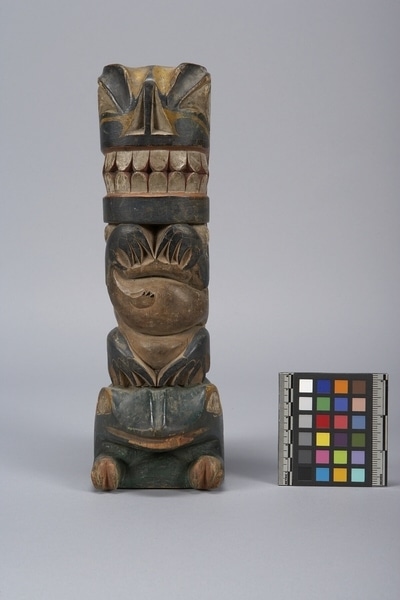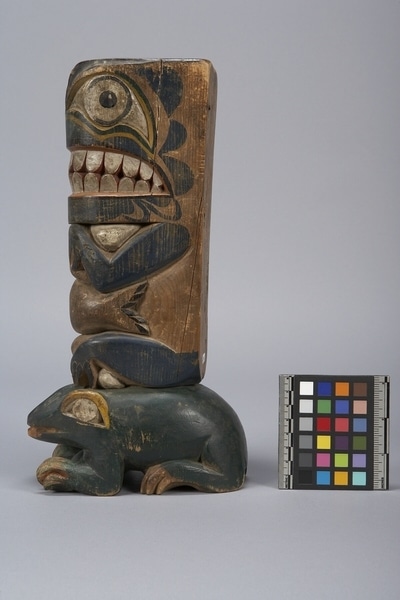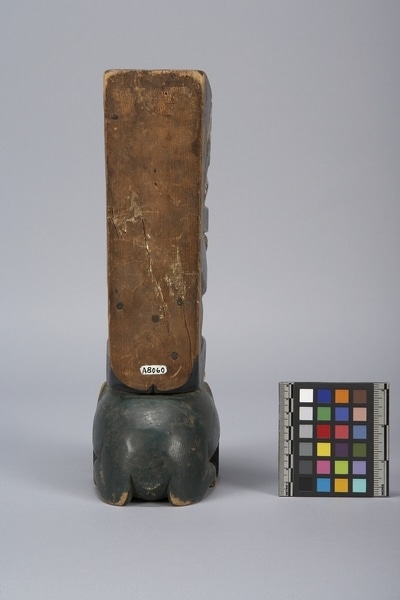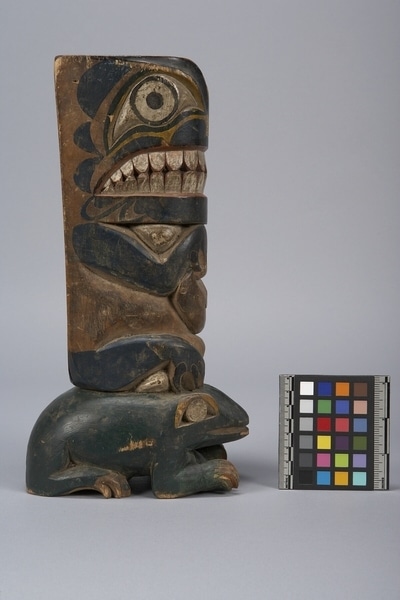Model Totem Pole Item Number: A8060 from the MOA: University of British Columbia





Description
Miniature totem pole depicting frog and a bear with sea lion. The green frog is at the base of the pole with the brown and black bear sitting on top. The sea lion is brown. There is a large hole at the top of the bear's head into which something can be placed. Painted red, black, and yellow on the natural brown wood. There are five nails in the back.
History Of Use
Traditionally, Coast Salish sculptures took the form of large-scale houseposts and boards, which were decorated with realistic looking animal, human and supernatural figures. Totem poles, originally only carved by their northern neighbours, became more popular in the early 20th century as tourist art. Many scholars feel that traditional styles of Coast Salish "art" were overlooked because it expressed private, non-secular experiences of the makers and they were reticent to discuss it or sell it to individuals outside of their communities. Miniature carved objects, such as totem poles and canoes, were popular forms of tourist art in the 20th century and are found in many museum collections.
Cultural Context
contemporary art; tourist art
Iconographic Meaning
Frog and bear each feature prominently in oral traditions from the Northwest Coast. The following account features the two of them together. "Until they were introduced recently, there were no frogs inhabiting the Queen Charlotte Islands, and legend explains why. When the Frog chief first encountered a black bear, he was terrified, particularly when the huge animal tried to step on the hopping creature for fun. The frog escaped, returned to his village, and related his frightening experience. Fearful that the bears would seek them out, the frogs decided to flee the islands (Stewart 1979:68)."
Item History
- Made in British Columbia, Canada
- Collected in Duncan, British Columbia, Canada between 1950 and 1962
- Owned by Chief Charlie Solwheymault
- Owned by Edith Bevan Cross before July 30, 1962
- Received from Edith Bevan Cross (Seller) and H. R. MacMillan (Funding source) on July 30, 1962
What
Who
- Culture
- Coast Salish: Quwutsun'
- Previous Owner
- Chief Charlie Solwheymault and Edith Bevan Cross
- Received from
- Edith Bevan Cross (Seller) and H. R. MacMillan (Funding source)
Where
- Holding Institution
- MOA: University of British Columbia
- Made in
- British Columbia, Canada
- Collected in
- Duncan, British Columbia, Canada
When
- Collection Date
- between 1950 and 1962
- Ownership Date
- before July 30, 1962
- Acquisition Date
- on July 30, 1962
Other
- Condition
- fair
- Current Location
- Case 6
- Accession Number
- 0081/0093